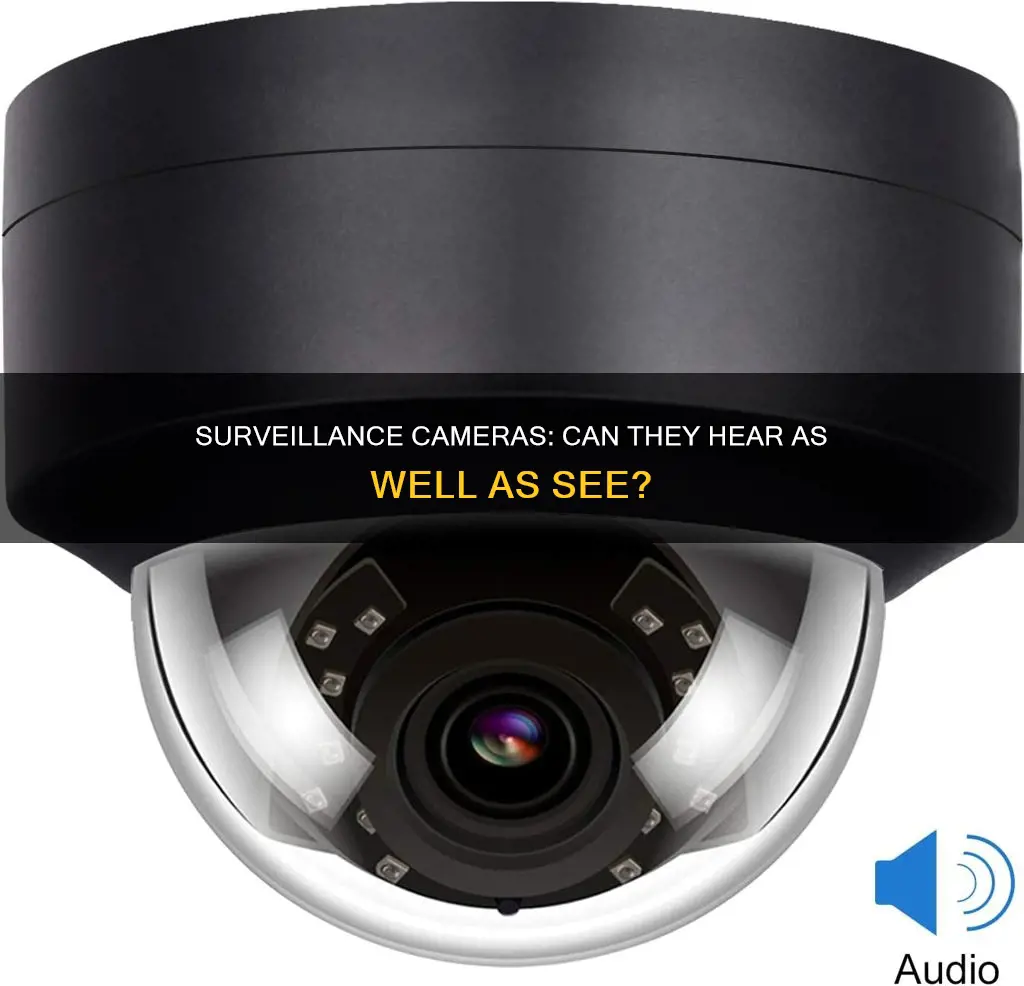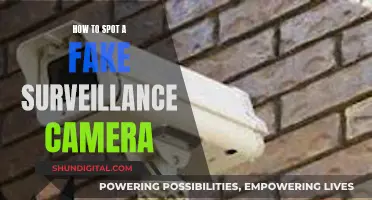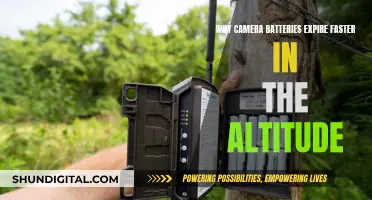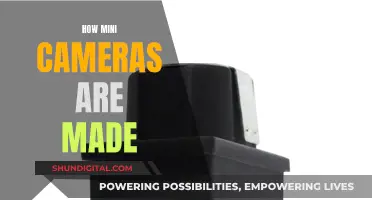
Security cameras with audio recording capabilities do exist. Older security cameras often had an add-on microphone to capture sound, while more advanced cameras have built-in audio capabilities. IP security cameras commonly have microphones, while traditional CCTV rarely supports audio. There are several types of security cameras with audio recording capabilities, including cameras with add-on microphones, in-built audio features, IP audio, and analog audio.
| Characteristics | Values |
|---|---|
| Surveillance cameras with audio recording capabilities | Exist |
| Security cameras with add-on microphones | Exist |
| Security cameras with in-built audio features | Exist |
| IP audio surveillance cameras | Exist |
| Analog audio surveillance cameras | Exist |
| Security cameras with two-way audio | Exist |
| Surveillance cameras with audio detection features | Can trigger immediate alerts |
What You'll Learn

Surveillance cameras with two-way audio act as a useful communication tool
Surveillance cameras with two-way audio are incredibly useful as they allow users to communicate in real-time with people on the other side of the camera. This can be done through an app or a control panel. For example, if you have a security camera at your front door, you can easily communicate with delivery people or unwanted visitors.
Two-way audio security cameras are also handy for monitoring pets, children, babies, and the elderly. For instance, if your pet is in distress but not in the camera frame, you can still hear them and speak to them through the camera's microphone to calm them down. Similarly, hearing a child or baby helps parents assess the situation and act accordingly.
Two-way audio security cameras also allow you to give instructions to delivery people, such as where to leave a package.
In addition, these cameras can be used to warn off burglars or intruders verbally.
Two-way audio security cameras can be wired or wireless. Wired cameras use a physical cable connection for power and data transmission, whereas wireless cameras are battery-powered and often connect to a WiFi or cellular network, enabling users to access live footage and communicate through a mobile app or web interface.
When purchasing a two-way audio security camera, it is essential to consider the sound quality, including the volume, clarity, and any delays in two-way communication.
The Best Camera Grip Battery Options and Their Lifespans
You may want to see also

IP audio surveillance cameras store data in the cloud
Surveillance cameras with microphones are typically IP cameras, which record or stream audio in addition to video. These modern IP cameras can be connected directly to the cloud for data storage. This is known as cloud IP camera storage.
IP camera cloud storage uses the internet to store your encrypted IP camera recordings in off-site cloud servers. This allows users to view, playback, delete, and download recordings from their cloud IP camera as long as there is a network. Wireless security cameras use a Wi-Fi network to send video recordings and live feeds to the cloud, while cellular cloud security cameras use 3G/4G data to send streams over the internet.
There are several benefits to storing surveillance data in the cloud. Firstly, it eliminates the need for complex on-site hardware and provides a single, secure location for data from multiple cameras. Cloud storage also offers advanced analytics and artificial intelligence capabilities, such as smart motion detection and object recognition, which can be used to search and retrieve relevant footage quickly. Additionally, cloud storage providers often have high data durability and robust security measures in place to protect your data from loss or unauthorised access.
However, there are also some considerations to keep in mind. Cloud storage usually requires a monthly subscription fee, and the amount of storage space may be limited. Additionally, the transfer of data to and from the cloud depends on a stable network connection. To mitigate this, local storage options like SD cards or Network Attached Storage (NAS) can be used in conjunction with cloud storage to ensure data is still captured locally if the internet connection is lost.
How Long to Charge Mobius Cameras Fully?
You may want to see also

Analog audio surveillance cameras use onsite DVRs
Many surveillance cameras have microphones, and some do not. Traditional CCTV cameras, for example, do not have microphones, whereas most IP security cameras do.
Analog audio surveillance cameras are one type of surveillance camera that can be used with microphones. These cameras capture video footage in an analog format and require a separate DVR (Digital Video Recorder) system to store and view footage. DVRs are devices that convert signals from an analog camera into a viewable digital format that can be stored on a hard drive. They are connected to analog cameras via coaxial cables and contain internal hard drives and encoding software, meaning all footage is processed and stored locally.
There are several benefits to using analog audio surveillance cameras with onsite DVRs. One advantage is cost-effectiveness. Compared to other systems like NVR, cloud, and hybrid cloud systems, DVRs are a more affordable security solution for small businesses. This is partly because DVR systems integrate with lower-quality cameras. DVRs also have secure connections since they do not require an internet connection to function. This not only allows them to be set up in remote locations but also eliminates the risk of being hacked.
Another benefit of analog audio surveillance cameras with onsite DVRs is instant access to footage. Since DVR systems are hardwired and connected directly to CCTV cameras, video is instantly stored on a hard drive and easily accessible for onsite surveillance staff. DVR systems can also be configured with special features like motion detection and time-stamping capabilities, enhancing their functionality.
However, there are also some challenges to using analog audio surveillance cameras with onsite DVRs. One drawback is minimal flexibility in terms of installation due to the need for DVRs to be located close to a power source. The use of coaxial cables for connections can also result in clunky wiring, and DVRs do not support audio capture. Additionally, DVRs may have lower image quality compared to other systems, and their storage capacity is limited since they cannot connect to the internet or utilise cloud storage.
Exploring VR Mode in Cameras: An Immersive Experience
You may want to see also

Older security cameras often require an add-on microphone
External security camera microphones are spherical or box-shaped, measuring a couple of inches in diameter. They can also look like small sticks at the end of a wire, taped to the camera itself. If you spot something that looks like a miniature smoke alarm with wires, it's likely an external microphone.
To connect an add-on microphone to a security camera, you will need an RCA coupler to attach the microphone to the camera, and a 12VDC power supply to provide power to the microphone. Once connected, the audio is combined with the video signal and sent over a cable to an NVR (Network Video Recorder).
It is important to note that the placement of a security camera with a microphone can significantly impact the extent to which it picks up relevant audio. In a quiet room, a security camera microphone can pick up sounds from a 40-foot radius. However, results may vary depending on ambient noise.
New Camera Battery Care: Do's and Don'ts
You may want to see also

Surveillance cameras with audio can help to avoid lawsuits
Surveillance cameras with audio capabilities can be a double-edged sword when it comes to privacy and legal considerations. While they can indeed help avoid lawsuits by providing comprehensive evidence in the event of disputes or incidents, there are also strict regulations governing their use.
Firstly, it's important to understand the distinction between CCTV and IP cameras. CCTV cameras rarely have native audio functions and do not support audio transmission through their coaxial cables. On the other hand, IP cameras, which are commonly used for home security, often include audio recording capabilities. These cameras usually have an obvious speaker on the back, consisting of dozens of holes arranged in a specific shape. Additionally, a single small hole near the lens, smaller than a pinhead, can indicate the presence of a microphone.
The primary legal consideration regarding audio surveillance is the expectation of privacy. It is generally illegal to record conversations or audio in private spaces without the consent of all parties involved. This includes areas such as bedrooms, bathrooms, and changing rooms. However, in public spaces, the expectation of privacy is lower, and audio recording may be permitted as long as it does not violate any specific laws. For example, it is illegal to use audio surveillance to eavesdrop on a private conversation that you would not normally be able to overhear.
The laws governing audio surveillance vary depending on the jurisdiction. In the United States, the federal Wiretap Act prohibits secretly recording conversations that an individual believes to be private. However, this act does not apply if at least one party in the conversation consents to being recorded. Additionally, some states have two-party consent laws, requiring the consent of all participants in a conversation for it to be recorded. These states include California, Delaware, Florida, Illinois, and Maryland, among others.
To avoid potential lawsuits, it is crucial to understand and comply with the specific laws and regulations in your area. This includes obtaining consent from individuals being recorded, refraining from recording in private spaces, and being transparent about the use of audio surveillance in public spaces.
In summary, surveillance cameras with audio can help avoid lawsuits by providing comprehensive evidence and reducing ambiguities in the event of disputes or incidents. However, it is essential to be mindful of privacy laws and obtain proper consent to ensure compliance with legal requirements.
Lorex and Dahua: What's the Camera Connection?
You may want to see also
Frequently asked questions
No, not all surveillance cameras have microphones. Older CCTV cameras, for example, rarely have audio recording capabilities.
There are several ways to tell if a security camera has a microphone. One way is to look for a cluster of holes on the back of the device, which is the speaker. Another way is to look for a single small hole near the lens, which is usually the microphone.
Yes, there are two main types of microphones for surveillance cameras: add-on microphones and built-in microphones. Add-on microphones are typically used with older security cameras, while built-in microphones are found in more advanced audio surveillance cameras.







